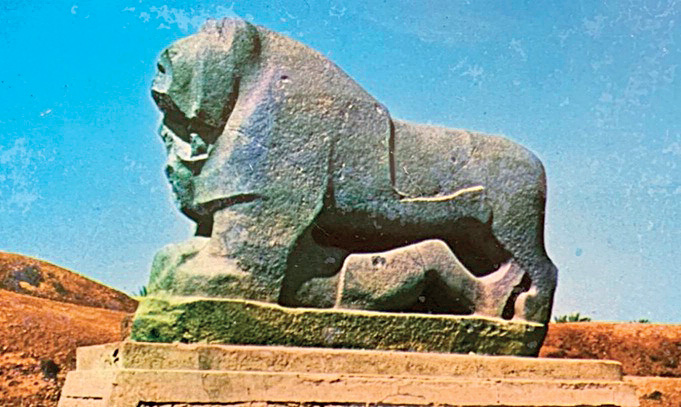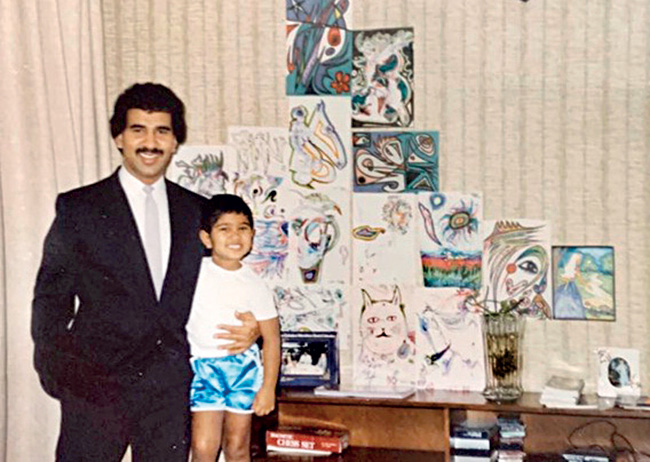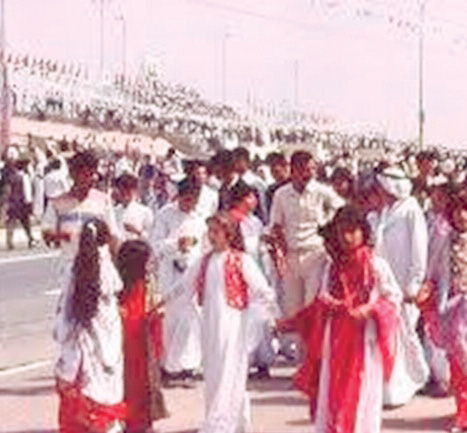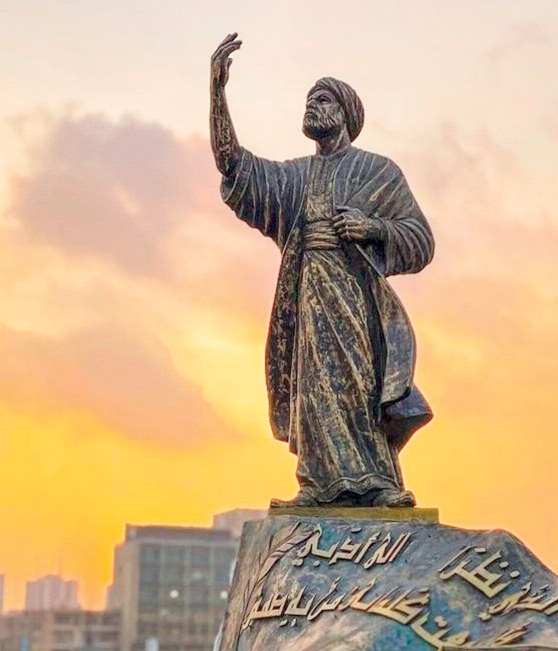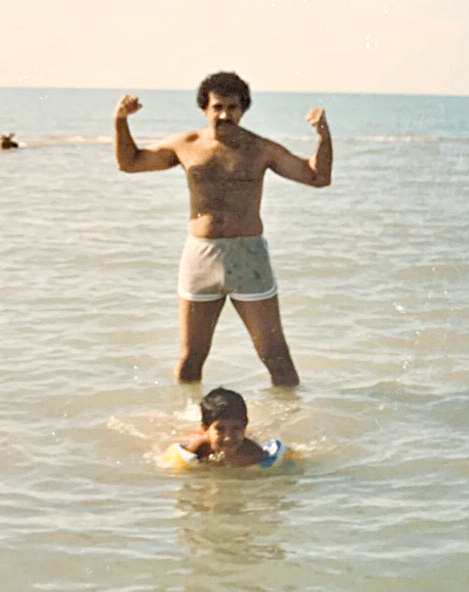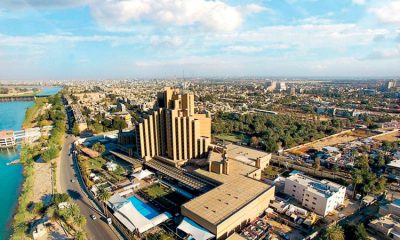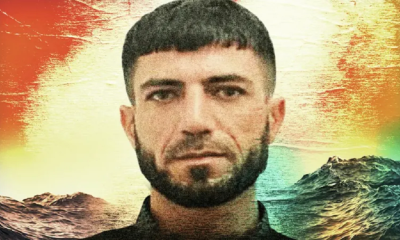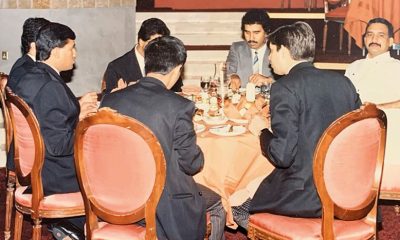Features
A Tourist in Iraq
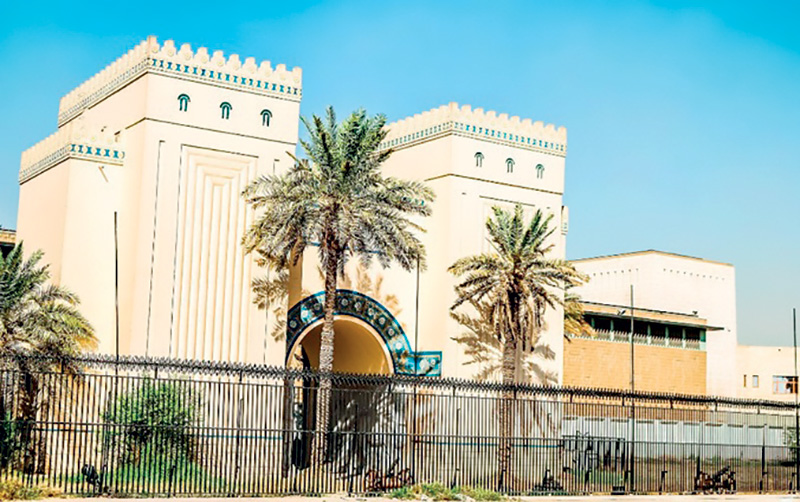
Part Three PASSIONS OF A GLOBAL HOTELIER
 Dr. Chandana (Chandi) Jayawardena DPhil
Dr. Chandana (Chandi) Jayawardena DPhil
President – Chandi J. Associates Inc. Consulting, Canada
Founder & Administrator – Global Hospitality Forum
chandij@sympatico.ca
When the 52 new recruits of Hotel Babylon Oberoi found themselves at a standstill, awaiting the final nod on their work permits, disappointment hung heavy in the air. The unforeseen two-week delay cast a shadow of uncertainty over our heads. Yet, rather than succumbing to frustration, I saw it as an opportunity—an unexpected window to explore the wonders of Iraq.
As we awaited bureaucratic clearance, I resolved to seize this hiatus as a chance to immerse myself in the rich tapestry of Iraqi culture. Having traversed much of the European Union, delved into Eastern Europe, wandered through Asia, and ventured into Africa briefly, the Middle East beckoned as the next chapter in my global odyssey. And what better place to begin than the vibrant heart of Baghdad?
With a thirst for knowledge and a hunger for adventure, I set out to uncover the layers of history and tradition that have shaped this land, despite its recent years of isolation due to conflict. It was time to embrace the warmth of Iraqi hospitality, delve into its ancient heritage, and unravel the mysteries hidden within its bustling streets and beyond…
Baghdad’s Treasures
Venturing beyond the confines of our hotel, we encountered an initial obstacle. A group of stern-faced police officers halted our progress, reminding us of the restricted zones that barred non-Iraqis. Undeterred, we quickly learned to navigate the city’s streets via taxi, ensuring our excursions continued unhindered.
Our curiosity led us to Baghdad’s renowned mosques, each a testament to the city’s rich cultural heritage. Yet, it was the allure of the national museum that truly captivated our interest. En route, our taxi driver insisted on a brief detour through the storied lanes of old Baghdad.
Al-Mutanabbi Street unfolded before us, a testament to centuries of literary legacy. Named after the revered 10th-century poet, Abul Tayeb al-Mutanabbi, the thoroughfare exuded an aura of historical significance. At its entrance stood an arch embellished with verses from the poet’s timeless works. An imposing bronze statue of al-Mutanabbi surveyed the flowing waters of the Tigris River which had influenced civilization throughout the known history of humanity.
- The Ishtar Gate
- The Lion of Babylon
Al-Mutanabbi’s literary prowess remains unmatched in the annals of Arabic literature. His verses, though often lauding the rulers of his era, bear testament to his sharp intellect and unparalleled wit. Through his poetry, he explored the intricacies of life’s philosophy, extolled the valour revered by Arab poets, and vividly depicted the tumultuous battles of his time. Yet, amidst the grandeur of his epic compositions, his verses also resonated with romance, adorned with exquisite similes and metaphors that continue to enrapture readers to this day. He says in one of his poems:
“The watchmen are not worried about the persons who visit you in the darkness because you are so beautiful and shining that you radiate in the darkness and anybody who meets you in the darkness is seen by your radiance. My beloved is very beautiful, and a very beautiful fragrance of musk is always emitted from her body as if she is made of musk. She is bright like the sun.”
The Iraq Museum nestles within the heart of Baghdad and stands as a testament to the enduring legacy of Mesopotamian civilization. Here, amid the echoes of ancient glory, the narrative of humanity’s journey unfolds amidst the relics of empires long past.
Inscribed upon the walls of this venerable institution is a history marked not only by triumphs and achievements but also by the sombre shadows of conflict and turmoil. Wars, with their crimson tide, have often marred the landscape where once peace, doves, and flowers flourished.
The museum’s history traces back to the aftermath of World War I, when European and American archaeologists embarked on expeditions that unearthed the treasures of Mesopotamia. In 1926, the Baghdad Archaeological Museum opened its doors, heralding the dawn of a new era in cultural preservation. By 1966, its expansive collection found a grand abode in the Al-Salihiyyah District, evolving into the renowned Iraq Museum. Within its hallowed halls reside the marvels of Babylonian, Sumerian, and Assyrian civilizations, alongside precious Islamic manuscripts, each whispering tales of bygone epochs.
The Iran-Iraq War of the 1980s forced its closure, compelling curators to safeguard its treasures from the ravages of conflict. Emerging unscathed, albeit sombre, it reopened its doors to a world hungry for knowledge and enlightenment, during the time I lived in Baghdad.
However, long after my time in Iraq, the dawn of the new millennium brought forth a harrowing chapter in the history of this museum. The looting that ensued during the chaos of the 2003 invasion stirred the echoes of ancient lamentations, as priceless artifacts vanished into the annals of uncertainty. Though the extent of the loss remains a subject of debate, the scars of that tumultuous period linger as a reminder of the fragility of our shared heritage.
As there were no signs of our work permits arriving, I suggested to a few of my colleagues, “let’s explore Babylon tomorrow,” but only a handful joined as others were pre-occupied with anxiety over the work permit challenge.
An Excursion in Babylon
Our quest for the ancient marvels of Babylon commenced with the break of dawn. Venturing some 100 kilometres south of Baghdad, we found ourselves amidst the remnants of a once-majestic civilization, nestled alongside the modern city of Al-Ḥillah. Babylon, an epitome of antiquity, stood proudly upon the banks of the Hilla branch of the Euphrates River, surrounded by a verdant expanse nourished by the waters of the Hilla canal.
Dating back to around 2,000 BCE, Babylon bore witness to the ebb and flow of empires across millennia. Under the reign of King Nebuchadnezzar II, its splendour reached unparalleled heights. His legacy, immortalized in the annals of history, adorned the city with three opulent palaces, resplendent in blue and yellow glazed tiles. The grandeur of Babylon, the city inside the walls occupied an area of 200 square miles encompassing an area roughly equivalent to modern-day Chicago, stood as a testament to human ingenuity and ambition, 4,000 years prior to our time.
Yet, the passage of time had not been kind to Babylon. Centuries of upheaval and plunder had stripped it of many treasures, smuggled away by European hands long ago. Under Saddam Hussein’s rule, efforts were made to resurrect the ancient city, albeit with mixed success.
The Ishtar Gate is central to Babylon’s allure, a marvel of ancient engineering and artistry. The Ishtar Gate was the eighth gate and the main entrance to the inner city of Babylon. Adorned with vibrant depictions of gods and goddesses, it stood as the portal to the city’s grand Processional Way, a path steeped in religious significance during the annual New Year celebrations. Lined with walls showing about 120 lions, bulls, dragons, and flowers on yellow and black glazed bricks, it symbolized the goddess Ishtar. Around the dawn of the twentieth century, excavations by German archaeologists had unearthed remnants of the gate.
King Nebuchadnezzar II also built several shrines, the largest of which, called Esagil, was dedicated to Marduk. The shrine stood 280 feet tall, nearly the size of a 26-story office building. Similarly elusive were the Hanging Gardens of Babylon, revered as one of the Seven Wonders of the Ancient World. Despite extensive searches, their precise location and existence remained shrouded in mystery. I was happy that the famous rooftop bar at Hotel Babylon Oberoi – ‘Hanging Gardens’ came within my portfolio.
The Lion of Babylon was among the few tangible relics of Babylon’s past, a stone sculpture dating back over 3,600 years. Carved from black basalt and weighing a staggering 7,000 kilograms, it depicted a Mesopotamian lion in a provocative pose above a supine human figure. The postures of the lion and human strongly suggest that they are having sexual intercourse. The statue is considered among the most important symbols of Babylon and Mesopotamian art in general. Rich in symbolism and heritage, the statue stood as a testament to Babylon’s enduring legacy, revered as a national symbol of Iraq.
As we immersed ourselves in the echoes of antiquity, the allure of Babylon’s storied past enveloped us. Amidst the ruins and relics, we glimpsed fragments of a civilization lost to time, a testament to the resilience of the human spirit across the ages. And as we retraced our steps back to Baghdad, the legacy of Babylon lingered in our hearts, a reminder of the enduring power of history to captivate and be inspired.
Exploring Northern Iraq
With work permits still pending, I found myself embarking on a journey to Mosul, Iraq’s second-largest city (with a population of 700,000 in 1989, and 1.8 million in 2024), under the directions of Madan Misra, the astute General Manager. Situated some 400 kilometres north of Baghdad along the banks of the Tigris River, Mosul held a storied past as the ancient Assyrian city of Nineveh, once the world’s largest metropolis.
Mosul is the major city in Northern Iraq. In 1989, Mosul stood as a vibrant cultural hub, blending historical richness with modern vitality. Its strategic location has long made it a nexus of trade and travel, with the majestic Mosul Dam serving as a testament to its enduring significance. The city’s annual spring events drew crowds from far and wide, infusing its streets with a palpable energy.
Returning from Mosul, my boss Misra, ever the discerning leader, sought my insights into the Nineveh Oberoi Hotel, a five-star hotel he oversaw. “Mr. Jayawardena, I must use your suggestions, wisely. You are new here and your eyes are fresh. Give me all details!”, he pushed me when I spoke diplomatically and gave him an edited version of my observations. Impressed with my extended feedback, Misra entrusted me with a new task: to evaluate a neglected resort hotel in Dokan, nestled near the Iranian border. He was eager to capitalize on potential opportunities for Oberoi business expansion in Iraq.
Although two hotels I managed in the past as General Manager – The Lodge and The Village at Habarana were not internationally branded, Misra knew that those were two of the largest and the best resort hotels in Sri Lanka. “Mr. Jayawardena, you are the only person in my team in Iraq who had been a hotel General Manager. Therefore, I am going to pick your brains from time to time!” I was pleased to hear that from my boss.
Embarking on the scenic journey northward towards Dokan, we marvelled at the diversity of the landscape. We paused for a refreshing dip at a lake and a sumptuous Kurdish lunch in Kirkuk, a city renowned for its multicultural tapestry. It is now identified as the ‘Jerusalem of Kurdistan’. Arriving in Dokan, we were greeted by the serene beauty of its surroundings, enhanced by the sparkling expanse of the Dokan Lake.
Marlon and I having a quick lake dip
Despite its natural allure, the resort in Dokan itself fell short of Oberoi standards, requiring substantial investment to meet the luxury benchmarks upheld by the brand. In my detailed report to Misra, I advised against Oberoi’s involvement in managing that property, recognizing the need for alignment with the company’s esteemed reputation and vision.
Re-commencing Painting
On returning to Baghdad, we were now counting nine days without formal work permits. I did not want to waste any time just idling. I decided to focus on an old hobby of mine – visual arts. At one point when I was 17-years old I displayed promise as a painter and a sculptor. My parents (who were both artists) and I discussed the option of my joining Heywood Art School in Ceylon (now the University of the Visual and Performing Arts) and becoming a professional painter and a sculptor. Instead, I joined Ceylon Hotel School and became a hotelier. However, back in my mind, I always wanted one day to become a semi-professional visual artist (which I am now).
In the mid-1980s, I took some private lessons from a veteran painter, Stanley Abeysinghe, who was a Past Principal of Heywood Art School, and a friend of my father. In Baghdad I started doing small paintings and encouraged my son, Marlon, to paint with me, as my father did, when I was Marlon’s age. After a few days, we had produced around twenty small abstract paintings on paper. Ignoring my wife’s annoyance, Marlon and I decorated a wall in our family suite with those paintings. Marlon called that wall, ‘Our Art Gallery’, and proudly encouraged any visitor to our suit to enjoy our artwork, and comment.
Finally, Allowed to Work
After 14 days of ‘no work’, we received the good news. Work permits for all 52 hotel employees who came from Sri Lanka had been approved by the Iraqi authorities. We were happy about it, and I was even more happy about the two ‘work-free’ weeks which allowed us to explore Iraq as tourists.
I immediately called a management meeting of my division and recommenced implementing our business plans, with my team. “Let’s create and promote a series of international food festivals with themes preferred by our Iraqi customers,” I motivated the team. We agreed to create a buzz and present food festivals and entertainment that Baghdad had never experienced before at a five-star hotel…
Features
The heart-friendly health minister

by Dr Gotabhya Ranasinghe
Senior Consultant Cardiologist
National Hospital Sri Lanka
When we sought a meeting with Hon Dr. Ramesh Pathirana, Minister of Health, he graciously cleared his busy schedule to accommodate us. Renowned for his attentive listening and deep understanding, Minister Pathirana is dedicated to advancing the health sector. His openness and transparency exemplify the qualities of an exemplary politician and minister.
Dr. Palitha Mahipala, the current Health Secretary, demonstrates both commendable enthusiasm and unwavering support. This combination of attributes makes him a highly compatible colleague for the esteemed Minister of Health.
Our discussion centered on a project that has been in the works for the past 30 years, one that no other minister had managed to advance.
Minister Pathirana, however, recognized the project’s significance and its potential to revolutionize care for heart patients.
The project involves the construction of a state-of-the-art facility at the premises of the National Hospital Colombo. The project’s location within the premises of the National Hospital underscores its importance and relevance to the healthcare infrastructure of the nation.
This facility will include a cardiology building and a tertiary care center, equipped with the latest technology to handle and treat all types of heart-related conditions and surgeries.
Securing funding was a major milestone for this initiative. Minister Pathirana successfully obtained approval for a $40 billion loan from the Asian Development Bank. With the funding in place, the foundation stone is scheduled to be laid in September this year, and construction will begin in January 2025.
This project guarantees a consistent and uninterrupted supply of stents and related medications for heart patients. As a result, patients will have timely access to essential medical supplies during their treatment and recovery. By securing these critical resources, the project aims to enhance patient outcomes, minimize treatment delays, and maintain the highest standards of cardiac care.
Upon its fruition, this monumental building will serve as a beacon of hope and healing, symbolizing the unwavering dedication to improving patient outcomes and fostering a healthier society.We anticipate a future marked by significant progress and positive outcomes in Sri Lanka’s cardiovascular treatment landscape within the foreseeable timeframe.
Features
A LOVING TRIBUTE TO JESUIT FR. ALOYSIUS PIERIS ON HIS 90th BIRTHDAY

by Fr. Emmanuel Fernando, OMI
Jesuit Fr. Aloysius Pieris (affectionately called Fr. Aloy) celebrated his 90th birthday on April 9, 2024 and I, as the editor of our Oblate Journal, THE MISSIONARY OBLATE had gone to press by that time. Immediately I decided to publish an article, appreciating the untiring selfless services he continues to offer for inter-Faith dialogue, the renewal of the Catholic Church, his concern for the poor and the suffering Sri Lankan masses and to me, the present writer.
It was in 1988, when I was appointed Director of the Oblate Scholastics at Ampitiya by the then Oblate Provincial Fr. Anselm Silva, that I came to know Fr. Aloy more closely. Knowing well his expertise in matters spiritual, theological, Indological and pastoral, and with the collaborative spirit of my companion-formators, our Oblate Scholastics were sent to Tulana, the Research and Encounter Centre, Kelaniya, of which he is the Founder-Director, for ‘exposure-programmes’ on matters spiritual, biblical, theological and pastoral. Some of these dimensions according to my view and that of my companion-formators, were not available at the National Seminary, Ampitiya.
Ever since that time, our Oblate formators/ accompaniers at the Oblate Scholasticate, Ampitiya , have continued to send our Oblate Scholastics to Tulana Centre for deepening their insights and convictions regarding matters needed to serve the people in today’s context. Fr. Aloy also had tried very enthusiastically with the Oblate team headed by Frs. Oswald Firth and Clement Waidyasekara to begin a Theologate, directed by the Religious Congregations in Sri Lanka, for the contextual formation/ accompaniment of their members. It should very well be a desired goal of the Leaders / Provincials of the Religious Congregations.
Besides being a formator/accompanier at the Oblate Scholasticate, I was entrusted also with the task of editing and publishing our Oblate journal, ‘The Missionary Oblate’. To maintain the quality of the journal I continue to depend on Fr. Aloy for his thought-provoking and stimulating articles on Biblical Spirituality, Biblical Theology and Ecclesiology. I am very grateful to him for his generous assistance. Of late, his writings on renewal of the Church, initiated by Pope St. John XX111 and continued by Pope Francis through the Synodal path, published in our Oblate journal, enable our readers to focus their attention also on the needed renewal in the Catholic Church in Sri Lanka. Fr. Aloy appreciated very much the Synodal path adopted by the Jesuit Pope Francis for the renewal of the Church, rooted very much on prayerful discernment. In my Religious and presbyteral life, Fr.Aloy continues to be my spiritual animator / guide and ongoing formator / acccompanier.
Fr. Aloysius Pieris, BA Hons (Lond), LPh (SHC, India), STL (PFT, Naples), PhD (SLU/VC), ThD (Tilburg), D.Ltt (KU), has been one of the eminent Asian theologians well recognized internationally and one who has lectured and held visiting chairs in many universities both in the West and in the East. Many members of Religious Congregations from Asian countries have benefited from his lectures and guidance in the East Asian Pastoral Institute (EAPI) in Manila, Philippines. He had been a Theologian consulted by the Federation of Asian Bishops’ Conferences for many years. During his professorship at the Gregorian University in Rome, he was called to be a member of a special group of advisers on other religions consulted by Pope Paul VI.
Fr. Aloy is the author of more than 30 books and well over 500 Research Papers. Some of his books and articles have been translated and published in several countries. Among those books, one can find the following: 1) The Genesis of an Asian Theology of Liberation (An Autobiographical Excursus on the Art of Theologising in Asia, 2) An Asian Theology of Liberation, 3) Providential Timeliness of Vatican 11 (a long-overdue halt to a scandalous millennium, 4) Give Vatican 11 a chance, 5) Leadership in the Church, 6) Relishing our faith in working for justice (Themes for study and discussion), 7) A Message meant mainly, not exclusively for Jesuits (Background information necessary for helping Francis renew the Church), 8) Lent in Lanka (Reflections and Resolutions, 9) Love meets wisdom (A Christian Experience of Buddhism, 10) Fire and Water 11) God’s Reign for God’s poor, 12) Our Unhiddden Agenda (How we Jesuits work, pray and form our men). He is also the Editor of two journals, Vagdevi, Journal of Religious Reflection and Dialogue, New Series.
Fr. Aloy has a BA in Pali and Sanskrit from the University of London and a Ph.D in Buddhist Philosophy from the University of Sri Lankan, Vidyodaya Campus. On Nov. 23, 2019, he was awarded the prestigious honorary Doctorate of Literature (D.Litt) by the Chancellor of the University of Kelaniya, the Most Venerable Welamitiyawe Dharmakirthi Sri Kusala Dhamma Thera.
Fr. Aloy continues to be a promoter of Gospel values and virtues. Justice as a constitutive dimension of love and social concern for the downtrodden masses are very much noted in his life and work. He had very much appreciated the commitment of the late Fr. Joseph (Joe) Fernando, the National Director of the Social and Economic Centre (SEDEC) for the poor.
In Sri Lanka, a few religious Congregations – the Good Shepherd Sisters, the Christian Brothers, the Marist Brothers and the Oblates – have invited him to animate their members especially during their Provincial Congresses, Chapters and International Conferences. The mainline Christian Churches also have sought his advice and followed his seminars. I, for one, regret very much, that the Sri Lankan authorities of the Catholic Church –today’s Hierarchy—- have not sought Fr.
Aloy’s expertise for the renewal of the Catholic Church in Sri Lanka and thus have not benefited from the immense store of wisdom and insight that he can offer to our local Church while the Sri Lankan bishops who governed the Catholic church in the immediate aftermath of the Second Vatican Council (Edmund Fernando OMI, Anthony de Saram, Leo Nanayakkara OSB, Frank Marcus Fernando, Paul Perera,) visited him and consulted him on many matters. Among the Tamil Bishops, Bishop Rayappu Joseph was keeping close contact with him and Bishop J. Deogupillai hosted him and his team visiting him after the horrible Black July massacre of Tamils.
Features
A fairy tale, success or debacle

Sri Lanka-Singapore Free Trade Agreement
By Gomi Senadhira
senadhiragomi@gmail.com
“You might tell fairy tales, but the progress of a country cannot be achieved through such narratives. A country cannot be developed by making false promises. The country moved backward because of the electoral promises made by political parties throughout time. We have witnessed that the ultimate result of this is the country becoming bankrupt. Unfortunately, many segments of the population have not come to realize this yet.” – President Ranil Wickremesinghe, 2024 Budget speech
Any Sri Lankan would agree with the above words of President Wickremesinghe on the false promises our politicians and officials make and the fairy tales they narrate which bankrupted this country. So, to understand this, let’s look at one such fairy tale with lots of false promises; Ranil Wickremesinghe’s greatest achievement in the area of international trade and investment promotion during the Yahapalana period, Sri Lanka-Singapore Free Trade Agreement (SLSFTA).
It is appropriate and timely to do it now as Finance Minister Wickremesinghe has just presented to parliament a bill on the National Policy on Economic Transformation which includes the establishment of an Office for International Trade and the Sri Lanka Institute of Economics and International Trade.
Was SLSFTA a “Cleverly negotiated Free Trade Agreement” as stated by the (former) Minister of Development Strategies and International Trade Malik Samarawickrama during the Parliamentary Debate on the SLSFTA in July 2018, or a colossal blunder covered up with lies, false promises, and fairy tales? After SLSFTA was signed there were a number of fairy tales published on this agreement by the Ministry of Development Strategies and International, Institute of Policy Studies, and others.
However, for this article, I would like to limit my comments to the speech by Minister Samarawickrama during the Parliamentary Debate, and the two most important areas in the agreement which were covered up with lies, fairy tales, and false promises, namely: revenue loss for Sri Lanka and Investment from Singapore. On the other important area, “Waste products dumping” I do not want to comment here as I have written extensively on the issue.
1. The revenue loss
During the Parliamentary Debate in July 2018, Minister Samarawickrama stated “…. let me reiterate that this FTA with Singapore has been very cleverly negotiated by us…. The liberalisation programme under this FTA has been carefully designed to have the least impact on domestic industry and revenue collection. We have included all revenue sensitive items in the negative list of items which will not be subject to removal of tariff. Therefore, 97.8% revenue from Customs duty is protected. Our tariff liberalisation will take place over a period of 12-15 years! In fact, the revenue earned through tariffs on goods imported from Singapore last year was Rs. 35 billion.
The revenue loss for over the next 15 years due to the FTA is only Rs. 733 million– which when annualised, on average, is just Rs. 51 million. That is just 0.14% per year! So anyone who claims the Singapore FTA causes revenue loss to the Government cannot do basic arithmetic! Mr. Speaker, in conclusion, I call on my fellow members of this House – don’t mislead the public with baseless criticism that is not grounded in facts. Don’t look at petty politics and use these issues for your own political survival.”
I was surprised to read the minister’s speech because an article published in January 2018 in “The Straits Times“, based on information released by the Singaporean Negotiators stated, “…. With the FTA, tariff savings for Singapore exports are estimated to hit $10 million annually“.
As the annual tariff savings (that is the revenue loss for Sri Lanka) calculated by the Singaporean Negotiators, Singaporean $ 10 million (Sri Lankan rupees 1,200 million in 2018) was way above the rupees’ 733 million revenue loss for 15 years estimated by the Sri Lankan negotiators, it was clear to any observer that one of the parties to the agreement had not done the basic arithmetic!
Six years later, according to a report published by “The Morning” newspaper, speaking at the Committee on Public Finance (COPF) on 7th May 2024, Mr Samarawickrama’s chief trade negotiator K.J. Weerasinghehad had admitted “…. that forecasted revenue loss for the Government of Sri Lanka through the Singapore FTA is Rs. 450 million in 2023 and Rs. 1.3 billion in 2024.”
If these numbers are correct, as tariff liberalisation under the SLSFTA has just started, we will pass Rs 2 billion very soon. Then, the question is how Sri Lanka’s trade negotiators made such a colossal blunder. Didn’t they do their basic arithmetic? If they didn’t know how to do basic arithmetic they should have at least done their basic readings. For example, the headline of the article published in The Straits Times in January 2018 was “Singapore, Sri Lanka sign FTA, annual savings of $10m expected”.
Anyway, as Sri Lanka’s chief negotiator reiterated at the COPF meeting that “…. since 99% of the tariffs in Singapore have zero rates of duty, Sri Lanka has agreed on 80% tariff liberalisation over a period of 15 years while expecting Singapore investments to address the imbalance in trade,” let’s turn towards investment.
Investment from Singapore
In July 2018, speaking during the Parliamentary Debate on the FTA this is what Minister Malik Samarawickrama stated on investment from Singapore, “Already, thanks to this FTA, in just the past two-and-a-half months since the agreement came into effect we have received a proposal from Singapore for investment amounting to $ 14.8 billion in an oil refinery for export of petroleum products. In addition, we have proposals for a steel manufacturing plant for exports ($ 1 billion investment), flour milling plant ($ 50 million), sugar refinery ($ 200 million). This adds up to more than $ 16.05 billion in the pipeline on these projects alone.
And all of these projects will create thousands of more jobs for our people. In principle approval has already been granted by the BOI and the investors are awaiting the release of land the environmental approvals to commence the project.
I request the Opposition and those with vested interests to change their narrow-minded thinking and join us to develop our country. We must always look at what is best for the whole community, not just the few who may oppose. We owe it to our people to courageously take decisions that will change their lives for the better.”
According to the media report I quoted earlier, speaking at the Committee on Public Finance (COPF) Chief Negotiator Weerasinghe has admitted that Sri Lanka was not happy with overall Singapore investments that have come in the past few years in return for the trade liberalisation under the Singapore-Sri Lanka Free Trade Agreement. He has added that between 2021 and 2023 the total investment from Singapore had been around $162 million!
What happened to those projects worth $16 billion negotiated, thanks to the SLSFTA, in just the two-and-a-half months after the agreement came into effect and approved by the BOI? I do not know about the steel manufacturing plant for exports ($ 1 billion investment), flour milling plant ($ 50 million) and sugar refinery ($ 200 million).
However, story of the multibillion-dollar investment in the Petroleum Refinery unfolded in a manner that would qualify it as the best fairy tale with false promises presented by our politicians and the officials, prior to 2019 elections.
Though many Sri Lankans got to know, through the media which repeatedly highlighted a plethora of issues surrounding the project and the questionable credentials of the Singaporean investor, the construction work on the Mirrijiwela Oil Refinery along with the cement factory began on the24th of March 2019 with a bang and Minister Ranil Wickremesinghe and his ministers along with the foreign and local dignitaries laid the foundation stones.
That was few months before the 2019 Presidential elections. Inaugurating the construction work Prime Minister Ranil Wickremesinghe said the projects will create thousands of job opportunities in the area and surrounding districts.
The oil refinery, which was to be built over 200 acres of land, with the capacity to refine 200,000 barrels of crude oil per day, was to generate US$7 billion of exports and create 1,500 direct and 3,000 indirect jobs. The construction of the refinery was to be completed in 44 months. Four years later, in August 2023 the Cabinet of Ministers approved the proposal presented by President Ranil Wickremesinghe to cancel the agreement with the investors of the refinery as the project has not been implemented! Can they explain to the country how much money was wasted to produce that fairy tale?
It is obvious that the President, ministers, and officials had made huge blunders and had deliberately misled the public and the parliament on the revenue loss and potential investment from SLSFTA with fairy tales and false promises.
As the president himself said, a country cannot be developed by making false promises or with fairy tales and these false promises and fairy tales had bankrupted the country. “Unfortunately, many segments of the population have not come to realize this yet”.
(The writer, a specialist and an activist on trade and development issues . )


